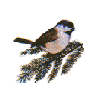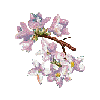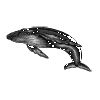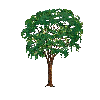|

|
Massachusetts State Bird - Chickadee
The Black-Capped Chickadee (Penthestes atricapillus) was
adopted as the official State Bird by the Massachusetts Legislature
on March 21, 1941. It is also known as the titmouse, tomtit, and
the dickybird, and it is one of the most familiar of the North
American birds. It is from four to five inches in size, its tail
accounting for nearly half its length. The general coloring is
ashy-grey, the back having a brownish tinge; the crown, nape,
chin, and throat are black, and the cheeks white. It nests in
a stump, tree, or fence post close to the ground, and broods twice
a year. It is a cheerful bird and has a pleasing call: "Chick-adee-dee-dee".
|
 |
State Game Bird or Game Bird Emblem
The Wild Turkey (Meleagris gallopavo), which was eaten
at the first Thanksgiving, was designated the state game bird
on December 23, 1991.
|
|

|
Cranberry - State Berry
Cranberry Juice was named the beverage of the Commonwealth on
May 4, 1970. This was a tribute to the great Massachusetts cranberry
industry, which grows one of the largest crops in the world.
A fifth-grade class on the North Shore adopted the cause of making
the Cranberry (Vaccinium macrocarpon) the official berry
of the state. Their two years of lobbying, petitions, and hearings
were finally rewarded in July of 1994.
|
|

|
Mayflower - State Flower
The Mayflower (Epigaea regens), also commonly known as
the ground laurel or trailing arbutus, has ovate hairy leaves
and fragrant, pink or white, spring-blooming flowers with five
petals. It grows in woods, preferring sandy or rocky soil, under
or near evergreens. It was adopted as the official flower of the
Commonwealth by the General Court on May 1, 1918. Unfortunately,
since 1925 it has been on the endangered list.
|
|

|
Boston Terrier - State Dog
The Boston Terrier (Canis familiaris bostenensis), first
purebred dog developed in America (1869); a cross between an English
bulldog and an English terrier. It was recognized by the Legislature
in 1979.
|
|

|
Right Whale - State Marine Mammal
The Right Whale (Eubabalena Glacialis) was so called because
the flourishing whaling industry in Massachusetts found the cetacean
the "right" whale to hunt, especially before 1750. Unfortunately,
the large, slow-moving mammal, which is found nearer shore than
many other whales, was hunted nearly to extinction and is only
now rebuilding its population. The Legislature adopted the whale
in March 1980.
|
|

|
Johnny Appleseed - State Folk Hero
The Legislature adopted Johnny Appleseed as folk hero on August
2, 1996. He was born John Chapman in Leominster in 1775, at the
time of independence. Chapman gained fame and his nickname because
of the apple trees he planted in rural areas beyond Massachusetts.
The apple blossom is the state flower in Arkansas and Michigan,
two of the far flung states that received his apple seedlings.
|
|

|
American Elm - State Tree
The American Elm (Ulmus Americana) was adopted as the
official tree March 21, 1941, to commemorate the fact that General
George Washington took command of the Continental Army beneath
one on Cambridge Common in 1775. It is a large tree, with gray
flaky bark. When growing in the forest it often attains a height
of 120 feet, but in the open it is wide-spreading and of lesser
height. The leaves are oval, and dark green, turning to a clear
yellow in the autumn. The American Elm, like most elms, has been
severely afflicted by Elm Disease.
|
|

|
Ladybug - State Insect
The Ladybug; also lady beetle, ladybird, ladyfly, etc. Most common
in the state is the Two-Spotted Lady Beetle (Adalia bipunctata).
Its head is black with pale yellowish margins; elytra reddish,
with two black spots. Idea originated in 1974 with a second-grade
class in the Town of Franklin.
|
 |
State Horse
The Morgan Horse was adopted as the official state horse in
1970. The first of this breed is said to have been born in 1789
in West Springfield, MA. Originally called "Figure", he could
outrun and outwork any horse in the area. Later, this horse became
known as the Morgan Horse after its original owner, Justin Morgan,
and is still admired today as a strong and sturdy horse.
|
| |
State Cookie
The Chocolate Chip Cookie was designated the official cookie
of the Commonwealth on July 9, 1997. A third grade class from
Somerset proposed the bill to honor the cookie invented in 1930
at the Toll House Restaurant in Whitman.
|
| |
State Bean
Cultivated plants and the colloquial names
for them change over the centuries, but in 1993
the legislature finally determined that the
Navy Bean had been the original bean in the
famous and venerable Boston Baked Bean recipe.
|
| |
State Muffin
The schoolchildren of Massachusetts petitioned for the Corn Muffin,
a staple of New England cooking, and the Legislature made it official
in 1986.
|
 |
State Dessert
The Boston Cream Pie, created in the 19th century, was chosen
as the official state dessert on December 12, 1996. A civics class
from Norton High School sponsored the bill. The pie beat out other
candidates, including the toll house cookie and Indian pudding.
|
 |
State Fish or Fish Emblem
The Cod (Gadus morrhua). A soft-finned fish, usually 10-20 lbs.
General coloring is olive grey with lateral lines paler than rest
of body tint. Indians and Pilgrims used them as common food and
fertilizer. A sculpture of a cod hangs in the House of Representatives
as a tribute to this useful aquatic creature. For over 200 years,
the emblem of the cod has remained a symbol of the Commonwealth's
economic beginnings, as the fishing industry provided the Puritans
with food, fertilizer, and revenue for trade.
|
 |
State Shell
The New England Neptune (Neptuna lyrata decemcostata) was made
the state shell in 1987.
|
 |
State Gem or Gem Emblem
Rhodonite is the most beautiful gem material
found in the state. It varies in hue from a light pink to a deep
rose or reddish pink and is associated with black manganese. It
was adopted in 1979.
|
 |
State Mineral or Mineral Emblem
The finest quality Babingtonite in America has
come from this state. Although the Commonwealth is not overly
blessed with mineral resources, it is one of the few locations
in the world where this usually jet black material with a brilliant
submetallic luster is found. The Legislature adopted it in April
of 1971.
State Rock or Rock Emblem
The Roxbury Puddingstone, sometimes called Roxbury
Conglomerate, became the state rock in 1983.
|
| |
State Historical Rock
Plymouth Rock. Although the Pilgrims did not
actually land on it, its historical significance led the Legislature
to commemorate it in 1983.
|
| |
State Explorer Rock
Dighton Rock was made the explorer rock of the
state in 1983.
|
| |
State Building Rock and Monument Stone
Granite was made the building rock of the State
in 1983. The last Ice Age did leave Massachusetts with exceptionally
fine samples of this rock; granite from Quincy was used to build
the Washington Monument.
|
| |
Soil of the Commonwealth
The Paxton Soil Series was adopted by the Legislature
on July 10, 1990.
|
 |
State Fossil or Fossil Emblem
The Dinosaur Tracks in Massachusetts, which were
made over 200 million years ago. In Granby, the prints of a theropod
dinosaur fifty feet in length from head to tail (the first record
of a theropod of such magnitude), were found. They were made the
official fossil in 1980.
|
![]()